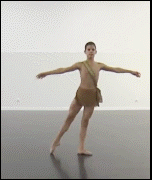Note that your final mark will not be saved in the system.
3.2.2.4 Angular motion GapFill
You must fill all the gaps before clicking ‘Check Answers!’

Angular motion is defined as the rotation of an object around a fixed and is sometimes referred to as rotational motion. One example of angular motion is an ice skater performing a pirouette during a routine. To classify as angular motion, an object must be following a rotational path with its centre of mass remaining constant.
Angular motion can be created through the application of an eccentric force about at least one of the three axes of rotation:
- Longitudinal: located from top to bottom through the centre of gravity
- Frontal: from front to back, through the centre of gravity
- Transverse: positioned from side to side, through the centre of gravity
Similar to linear motion, there are various quantities involved in angular motion:
| 1. | Angular (degrees or radians) – the shortest difference between the starting angle and the end angle. |
| 2. | Angular velocity (
) – the rate of angular
of an object. This is calculated by: angular / |
| 3. | Angular
(rad/s2) – the rate of change in angular velocity. This is calculated by: end angular velocity – starting angular velocity / time taken (s) |
| 4. | Angular momentum (
) – the amount of angular motion present in an object. This is calculated by: angular momentum = moment of inertia x angular |
| 5. | Moment of inertia (
) – the resistance of an object to change its current state of rotational motion. This is calculated by: the sum of (mass x distance from the 2) |
There are two factors affecting the moment of inertia:
- of the body – the greater the mass, the larger its moment of inertia. This is because it is much harder to change the state of motion of a heavy object, e.g. it is much harder to squat a 200 kg weight than it is to squat a 50 kg weight.
- Distribution of mass from the axis of rotation – the greater this distribution of mass, the larger the moment of inertia of the body. This is best represented by gymnastic movements in flight:
- Assuming a tuck position by using the arms to draw the knees close to the chest results in a small distribution of mass which is concentrated towards the centre of mass.
- A pike position uses the arms to pull the posterior of the legs lose to the chest, while keeping the legs straight. The distribution of mass in this position is larger than the distribution of mass in the tuck position but is still effective in reducing the moment of inertia.
- An extended body position, such as that adopted in Olympic diving upon entering the water, results in a large distribution of mass away from the centre, and thus a greater moment of inertia.
There is an inverse relationship between the moment of inertia and angular velocity, whereby an increase in the moment of inertia is mirrored by a decrease in angular velocity. It can be represented by the following equation, also used to calculate angular velocity:
angular velocity = angular momentum / moment of inertia
This can be rearranged into the calculation for angular momentum shown earlier, and is the best way to picture the relationship between angular velocity and moment of inertia, which effectively cancel each other out during flight, resulting in an unchanged angular momentum of the body when it is in the air. This is consistent with the angular analogue of Newton’s – that an object will continue in its current state of motion, in this case rotation, unless an external force is exerted upon it. This demonstrates that without the application of an external force, the angular momentum of the object will remain unchanged, and is more commonly referred to as the of angular momentum.